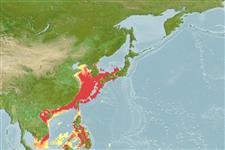Common names from other countries
Classification / Names / Names
俗名 | 同种异名 | Catalog of Fishes (gen., sp.) | ITIS | CoL | WoRMS
Environment: milieu / climate zone / depth range / distribution range
生态学
海洋洄游的 (Ref. 75927); 深度上下限 10 - 150 m (Ref. 275), usually 60 - 150 m (Ref. 75927). 15°C - 25°C (Ref. 75927); 41°N - 6°N, 104°E - 138°E (Ref. 1695)
分布
国家 | FAO区域 | 生态系 | 标本纪录 | 简介
Western Pacific: South and East China seas, Japan to Philippines and Indonesia.
Length at first maturity / 大小 / 重量 / 年龄
Maturity: Lm ? range ? - ? cm Max length : 18.0 cm ML 雄鱼/尚未辨别雌雄; (Ref. 275); 最大体重: 600.00 g (Ref. 1695)
Caught by otter trawls, pound nets, hoop nets and hook-and-line (Ref. 346).
Life cycle and mating behavior
成熟度 | 繁殖 | 产卵场 | 卵 | 孕卵数 | 仔鱼
Members of the class Cephalopoda are gonochoric. Male and female adults usually die shortly after spawning and brooding, respectively. Mating behavior: Males perform various displays to attract potential females for copulation. During copulation, male grasp the female and inserts the hectocotylus into the female's mantle cavity where fertilization usually occurs. Life cycle: Embryos hatch into planktonic stage and live for some time before they grow larger and take up a benthic existence as adults.
主要参考文献
参考文献 | 合作者 | 合作者
Roper, C.F.E., M.J. Sweeney and C.E. Nauen. 1984. (Ref. 275)
世界自然保护联盟红皮书 (Ref. 130435: Version 2024-1)
Not Evaluated
Not Evaluated
人类利用
渔业: 商业性
| FishSource |
工具
网络资源
Estimates based on models
Preferred temperature
(Ref.
115969): 11.6 - 23.2, mean 18.5 (based on 195 cells).
Prior r = 0.31, 95% CL = 0.20 - 0.47, Based on 1 full stock assessment.
脆弱性
Low vulnerability (10 of 100).
